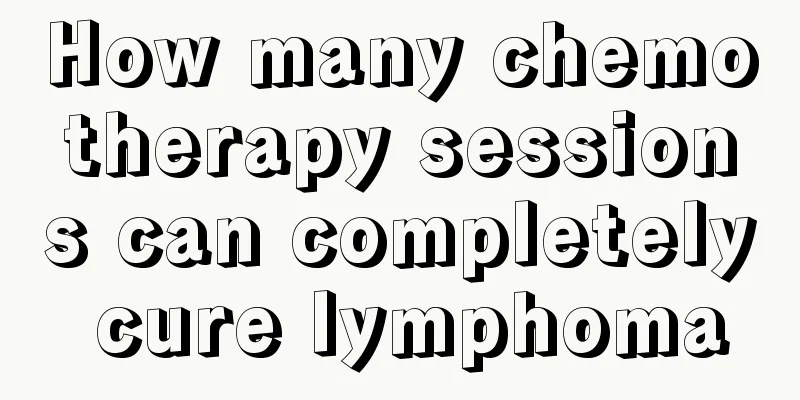How many chemotherapy sessions can completely cure lymphoma

|
Lymphoma is a malignant tumor originating from the lymphatic hematopoietic system. It is mainly manifested by painless lymphadenopathy, hepatosplenomegaly, and all tissues and organs of the body may be affected, accompanied by systemic symptoms such as fever, night sweats, weight loss, and itching. If you get the disease, you should seek treatment in time. Chemotherapy is the most commonly used method. Can lymphoma be cured? The answer is yes. So how many chemotherapy treatments can completely cure lymphoma? Let's take a look at the following introduction. Experts suggest that the question of "how many times of chemotherapy can completely cure lymphoma" cannot be generalized, because it is related to many factors, such as the patient's condition and the hospital chosen by the patient. When you have this disease, you must not be afraid of medical treatment and should go to a regular hospital for treatment in time. Lymphoma is highly heterogeneous, so the treatment varies greatly. Different pathological types and stages of lymphoma vary greatly in terms of treatment intensity and prognosis. The treatment methods for lymphoma are mainly the following, but specific patients should be analyzed according to their actual conditions. Treatment options include surgery, radiotherapy, bone marrow transplantation, chemotherapy, and lymphoma chemotherapy mostly uses combined chemotherapy, which can be combined with targeted therapeutic drugs and biological agents. Specific guidance is required based on the condition and chemotherapy effect. It is recommended that professional outpatient systems guide treatment! Some early signs are particularly noteworthy: 1. Progressive lymphadenopathy without clear cause, especially when the location, hardness, and mobility are consistent with the characteristics of malignant lymphoma. 2. "Lymph node tuberculosis" is not responding to regular anti-tuberculosis treatment, and "chronic lymphadenitis" is not responding to general anti-inflammatory treatment. 3. Lymphadenopathy and fever sometimes improve after treatment, but they often recur and the overall trend is progressive. 4. Unexplained long-term low-grade fever or periodic fever, especially accompanied by itchy skin, sweating, weight loss, and superficial lymphadenopathy. |
<<: What are the folk remedies for treating lymphoma
>>: Is the cure rate of lymphoma high?
Recommend
Symptoms of plateau hypoxia
Usually after holidays, people will travel to a p...
What should you pay attention to after lung cancer surgery? Pay attention to these four aspects
After lung cancer surgery, measures should be tak...
Can I eat mangoes when I have a cold? What fruit is better to eat?
Generally speaking, it is not recommended to eat ...
What are the methods of dietary treatment for bulbar ulcer symptoms
Bulb ulcer is also known as gastric and duodenal ...
How to treat knee wear? These methods are effective quickly
People who engage in heavy physical activities or...
Is running in the early morning good for your health?
Sports medicine has proven that when you just wak...
Systemic nursing measures for bedsores in patients with rectal cancer
If rectal cancer patients stay in bed for a long ...
How long after renovation is it better to move in
You cannot move into a new house immediately afte...
What is the redness around the anus
Although the anus performs the dirtiest job in th...
Will I definitely not have my period if I'm pregnant?
We all know that a woman's body will undergo ...
Eye care must be done well!
Eyes are organs that people use to perceive objec...
Can sweet potatoes and pumpkins be eaten together?
Sweet potato and pumpkin are two common delicacie...
How to use tomatoes to control prostate cancer
Tomatoes are a kind of food that we often eat, bu...
Explain the common causes of lung cancer
Lung cancer is seriously harmful to our body. Wha...
Do patients with nasopharyngeal carcinoma need radionuclide examination?
With the rapid development of medical technology,...









